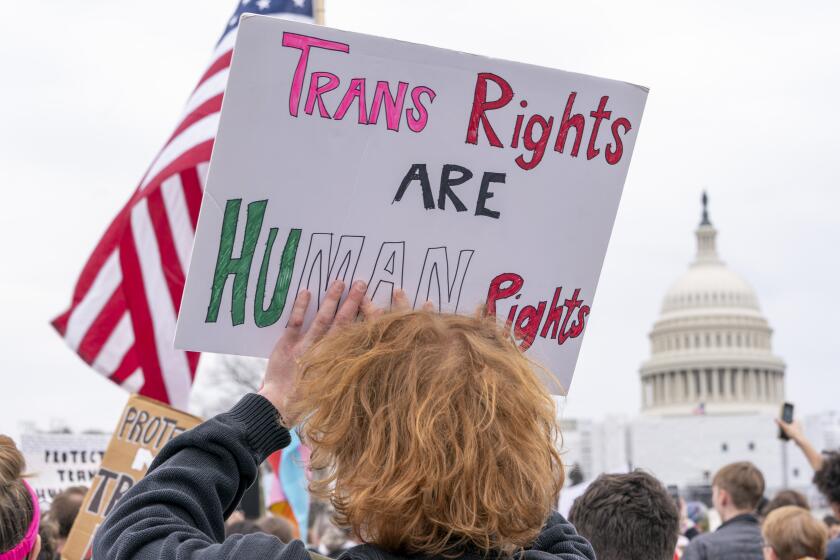Judges: The Law Is the Law
- Share via
Almost anyone on President Bush’s short list of Supreme Court nominees will rouse Senate Democrats to filibuster. No one seriously believes that this will happen because his picks will lack proper training, integrity or temperament. Rather, what riles Democrats is Bush’s repeated assertion that he will not appoint someone who “legislate[s] from the bench.” They and their allies believe that Bush’s opposition to judicial activism cloaks his real desire to fill the court with like-minded conservatives.
They are wrong. The president’s view on activist judges is a defensible, neutral principle of appointment.
Democrats and Republicans are quick to hurl the term “judicial activism” at each other. The Warren court is condemned for elevating criminal-defendant rights over police needs, the Rehnquist court for expanding the power of states at the expense of the federal government.
A study praised by both liberals and conservatives -- and that happens to have been done by my son, Keenan -- found the phrase used thousands of times in scholarly articles and judicial opinions, but its meaning frequently came down to “a decision one does not like.” Even Justice Antonin Scalia, one of Bush’s favorite jurists, described “judicial activism” as “totally imprecise ... just nothing but fluff.” The problem is that common usage doesn’t tell us where judicial restraint ends and judicial activism begins.
A clue to where the line should be drawn can be found in the words of the late Democratic Sen. Sam Ervin, who chaired the Watergate hearings. He said a “judicial activist ... is a judge who interprets the Constitution to mean what it would have said if he, instead of the founding fathers, had written it.”
Implicit in his observation is the understanding that the Constitution is a text with a discernible meaning. Although that may seem obvious to the average citizen, many U.S. law schools do not subscribe to it.
For the last half a century, law students have been taught that cases are not decided on the basis of formal, authoritatively adopted rules and principles but on the basis of a judge’s cultural and social intuitions. “Legal realism,” as it is called, turns judging into a matter of force or will (personal preference) rather than the exercise of reason, the method called for by Alexander Hamilton in the “Federalist Papers.” When judges disregard Hamilton’s advice, they inject politics into judicial judgment and invite it into confirmation proceedings.
Restoring an understanding of the law and the Constitution as text, rather than as jumping-off points for ideological excursions, is an uphill battle, yet it is the only faithful way for a judge to discharge his or her duty.
Opponents of judicial restraint are more evasive than coherent. Some students of linguistics make the logical, though theoretical, point that words are merely conventions of a community and thus can be given any meaning. But none of us live in this world, whether we are following the terms of a contract or a grocery list. Nor is such pedantry harmless. The pre-Civil War Supreme Court held that Americans of African descent didn’t merit freedom because they were not “persons,” as subjectively defined by the court in defiance of the objective truth of human nature.
A better knock on judicial restraint is that it makes the Constitution rigid and insensitive to the needs of the 21st century. But once a personal judicial view of what is good policy is given a constitutional stamp of approval, it is inoculated from change except by constitutional amendment. That’s hardly flexible. Opponents of judicial restraint extol the need for a “living Constitution,” but the document’s life is secured by “we the people,” not we the judges.
Advocates of judicial activism cannot justify it on the grounds that it is a long-standing practice. When it became obvious in the 1920s that there was no constitutional basis to deny the franchise to women, the right to vote was expanded by amendment, not by judicial fiat.
Contrast this approach with that of today’s proponents of same-sex marriage, who contend that the 14th Amendment’s equal protection clause should be newly understood by judges to embrace such unions. Because marriage and procreation are linked, and the family is important to civil order, any case for same-sex marriage ought to be made in a public forum, not in a courtroom.
Respect for democratic choice must be principled. You cannot appeal to the silence of the constitutional text on homosexual practices and abortion as grounds to withhold their judicial blessing, then ignore that same silence when the business community wants judges to read into the document limitations on punitive damages. Excessive punitive damages may be harmful to medicine and other fields, but devising their limits is a legislative task.
Don’t misunderstand. The Constitution is not simply a device to give the majority its way. At least since John Marshall and Marbury vs. Madison (1803), it is the job of judges to ensure that lawmakers stay within the federalist structure of enumerated powers and observe the Bill of Rights. Coercing prayer is just as constitutionally misbegotten as forcibly taking someone’s property without a genuine public use. As Scalia puts it, his most important function, when warranted, is to “tell the majority to take a walk.”
But note as well that our ability to secure religious, economic or any other freedom diminishes appreciably when the Constitution is understood to be premised not on original understanding but on a judge’s view of “evolving consensus.”
Judicial candidates should be asked one question: Will they faithfully follow the law as ratified or enacted and not follow their personal preferences?
Restrained judges secure democratic rule and ensure against the abuse of power. Activists on the bench undermine both.
More to Read
Get the L.A. Times Politics newsletter
Deeply reported insights into legislation, politics and policy from Sacramento, Washington and beyond. In your inbox twice per week.
You may occasionally receive promotional content from the Los Angeles Times.










